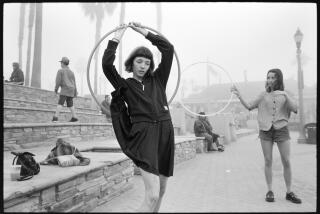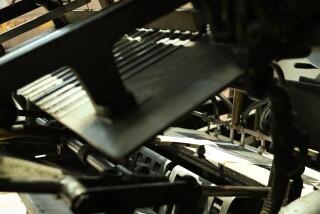It’s a Special Type of Beauty
Bride-to-be Ashley Braband didn’t know letterpress from a sandwich press when she walked into Soolip Paperie & Press in West Hollywood several months ago looking for wedding invitations. But once she ran her fingers across a letterpress card and felt the subtle landscape created by inked metal pressed into paper, she was sold.
“Each piece looked handcrafted,” said the 23-year-old Los Angeles human resources director, whose Napa Valley wedding is scheduled for the fall. “It gives a lasting effect--it makes it look like it’s going to be on the paper for years and years. A lot of people have been writing back on the response cards, ‘Wow, what an invitation!’”
Braband isn’t the only one discovering the 600-year-old art of letterpress, the original form of mechanized printing that dates back as far as the Guttenberg Bible. The craft is enjoying a comeback in stationery and custom invitations and announcements. Around the region, 100-plus-year-old presses are clacking away, from Soolip on Melrose to Aardvark Letterpress on 7th Street near downtown, to the Claudia Laub Studio and Gallery in Hancock Park to the Fine Paper Co. in Old Town Pasadena.
At Claudia Laub Inc., a retail-wholesale business Laub sold to partner Jonathan Wright Herpick last year, printer Nelson Ayala is making stationery with a shell motif in flamingo pink. In the back of this small store, working on a 19th century press, he takes a sheet of ivory paper and carefully positions it on one of the press’ flat surfaces. The engraved metal die with the shell motif faces the paper, and after it’s been inked it’s pressed into the paper, leaving a slight impression that transforms the blank sheet into a mini work of art.
Ayala examines the proof, peering through a clear plastic grid to make sure the design is straight and centered, then checks to see if the ink is consistent. A small motor operates the machine, which originally was powered by foot treadles; once Ayala sets the press in motion the large flywheel, rollers and plates swing gracefully amid the cacophony of clicks, clacks and bangs, sending heady whiffs of ink into the air.
It can take months, sometimes years, to acquire the intuition to gauge the precise amount of ink needed, to learn how to position the paper just so and to adjust the press for varying thicknesses of paper. Hand-setting type is a painstaking process in which individual letters, from sliver-sized pieces to big blocks, are aligned and spaced. Yet as careful as the most practiced printer becomes, the charm of letterpress lies in the finished product’s slight imperfections, which speak to its handmade roots.
By contrast, offset printing, the process that replaced letterpress in the 20th century, uses printing plates and rollers. It is both more efficient and less labor-intensive than letterpress, but it loses the depth and dimension.
Though more businesses offering letterpress products are springing up, each has its own look and style, reflecting the tastes of the individual designers and printers, ranging from Victorian engravings of frogs to whimsical graphics of children and minimalist modern designs of cocktail glasses. Most images are rendered in one or two colors, and some feature hand-painted images.
The final product isn’t cheap. A letterpress greeting card can cost $7. Custom birth announcements can run about $500, and multi-part invitations can shoot up into the tens of thousands of dollars. As details escalate, so do prices. A wedding invitation package, for instance, could include a save-the-date card, the invitation itself, matching envelope, response card and envelope, and thank-you notes. Each one can incorporate handset type and custom-designed icons made into engraved copper dies. The medium is often associated with specialty handmade papers, complex folds, plus additions such as hand-tied ribbons, dried flowers and wax seals. All of these up the ante considerably.
Although they are the most common letterpress products, stationery and invitations are not all that letterpresses can be used for. Several small presses in the U.S. have produced limited-edition handmade books, among them Arion Press in San Francisco and Thornwillow Press in New York.
In recent years, letterpress has found a fan base in the 25-and-under crowd who grew up with a mouse in one hand and a video game joystick in the other. They’re filling letterpress classes at local art and design schools, including Otis College of Art and Design in L.A., and Armory Center for the Arts and Art Center College of Design in Pasadena. But it’s Martha Stewart who is most widely credited with bringing back interest in the process after she included an article on letterpress in her magazine.
“Part of [the interest] is a reaction to the technology we’re surrounded with,” says Scott Ward, Armory’s executive director. “This is clearly a tactile medium. You literally have to put an ‘A’ into position to print an ‘A’ on a sheet of paper. It’s such a switch from the digital world.”
Doing letterpress commercially requires a huge commitment. Presses are often tracked down by a small group of middlemen who seek out defunct print shops and abandoned newspaper presses. Depending on how the presses are found, whom they belong to, and their condition, prices can run from $100 to thousands. One of the presses at the Claudia Laub Studio and Gallery is from the late 19th century and once belonged to the Los Angeles Times. Wanda Wen, owner of Soolip and a 10-year veteran of letterpress, said she found her presses, one from 1890 and one from the 1920s, via newsletters: “I had them trucked over sight unseen and put them in my garage until we found studio space,” she says.
Printers also stalk flea markets and scour online auctions and classified ads looking for wood and metal type and dingbats--little icons and designs such as hearts, leaves or flowers.
“I love taking the blank piece of paper and sticking it in the press, and when it comes out a second later it all of a sudden has power,” says Laub, who’s been letterpress printing for 30 years. “I love picking up each one and looking at it, making sure it’s right. I love using handmade paper that has thicker and thinner areas, and the type bites into the thicker area a little more than the thinner area. In letterpress, the letters dance a bit.”
Laub now concentrates on custom work, which she does from her home. Rummaging through an antique oak chest in her living room, she pulls out card after card--an elegant wedding invitation with entwined wedding rings, a birth announcement with a baseball player etched in navy, a bat mitzvah invitation with intricate folds.
Not every customer who chooses letterpress is familiar with the process; printers say they usually give their clients a brief education to explain the work involved. But printers seem satisfied if their clients simply share an aesthetic.
“The majority of people who come in know what we’re about,” says Wen, “but a lot of people who don’t know it’s letterpress just like the aesthetic. If I had to put it into words, our style is clean, simple, uncluttered, and some people have said it has a certain ‘Zen-ness’ to it. It has a purpose to it.”
“People are appreciating printing again, and letterpress is a very elegant form of printing,” says Cary Ocon, part of the 34-year-old, family-run Aardvark Letterpress. “We do educate some of our customers, but more and more people are coming in asking for it. They seem to know what it is.”
Cynthia Morgan, stationery buyer for Kate’s Paperie stores in New York, says that in the last few years she’s seen more young entrepreneurs--mostly women--try their hand at letterpress.
“Three years ago, we carried two companies that did letterpress,” she said, “and now we have five, maybe six. That so many young people are doing letterpress is great; it’s heartening. I think young people hunger for the roughness of it.”
Lucky Dare, who heads the letterpress lab at Otis, hears the same thing from her students, who incorporate new technology with old. Designs for letterpress can be rendered on a computer, then made into polymer plates that can be used instead of metal dies. “The technology,” she says, “brings letterpress into the 21st century.”
Some letterpress printers and aficionados fear that this renewed interest in the craft could bring the taint of trendiness, attracting printers who want to catch the wave but don’t share the passion.
“It’s a craft to which you have to devote attention and intention,” says Helen Driscoll, owner of Fine Paper Co. “If something becomes trendy, there’s no respect for it, and a lot of people will treat it like photocopy. It’s good that there’s an appreciation being developed. When people are part of the process, they acquire an appreciation when they realize what’s involved.”
For Ashley Braband, the time and money spent (she estimates between $15,000 and $20,000) for custom, one-of-a-kind invitations was worth it.
“We have a lot of family and friends coming from overseas,” she explains, “and we wanted a striking invitation that would get people excited and also set the mood for the occasion. We’re having a week of events for the wedding, which is during the harvest season, so all the pieces are very earthy. I wanted them to give an elegant yet relaxed feeling. People have said it’s the most beautiful invitation they’ve ever seen.”






